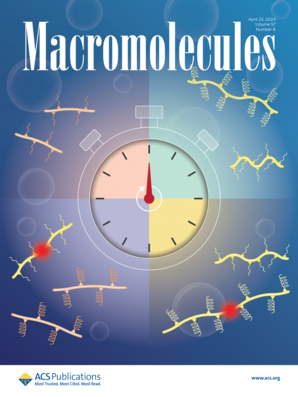Can Dynamic Helical Polymers be Reduced to Linear Chains of Spins? Non-Local Effects from Polymer Self-Avoidance
IF 5.1
1区 化学
Q1 POLYMER SCIENCE
引用次数: 0
Abstract
Cooperative chiral order in dynamic helical polymers (DHPs) is commonly understood through their reduction to one-dimensional (1D) Ising-spin chains. In this framework, each spin, adopting the values σ = −1 and σ = 1, represents a left- and right-handed helical twist. Spins interact ferromagnetically, capturing the energetic cost of boundaries between domains of opposite chirality. All current spin models of DHPs assume that nearest-neighbor (NN) spin–spin interactions suffice to describe the system. We challenge this assumption using a minimal molecular model to investigate whether the self-avoidance of DHP chains, due to excluded volume, induces an effective, non-local coupling of spins. Our approach combines a 1D description of helicity, based on NN spin–spin interactions, with an explicit representation of DHPs as freely-jointed chains with flexible hinges. We generate both ideal and self-avoiding chain conformations through a Monte Carlo scheme. For ideal chains, the spin behavior agrees with the predictions of a NN 1D Ising model with coupling strength J. However, we find that chain self-avoidance does create effective long-range interactions, as demonstrated by spin–spin correlation functions and free-energy calculations. These interactions renormalize J and lead to finite-size effects that are inconsistent with the NN 1D Ising behavior.

动态螺旋聚合物可以简化为线性自旋链吗?聚合物自我回避的非局部效应
动态螺旋聚合物(DHPs)的合作手性顺序通常是通过将其还原为一维(1D) ising自旋链来理解的。在这个框架中,每个自旋,采用σ = - 1和σ = 1的值,代表一个左旋和一个右旋螺旋扭。自旋以铁磁性相互作用,捕获手性相反的域之间边界的能量代价。目前所有的dhp自旋模型都假设最近邻(NN)自旋-自旋相互作用足以描述系统。我们使用最小分子模型来挑战这一假设,以研究由于排除体积,DHP链的自我回避是否诱导了有效的非局部自旋耦合。我们的方法结合了基于神经网络自旋-自旋相互作用的一维螺旋度描述,以及dhp作为具有柔性铰链的自由连接链的显式表示。我们通过蒙特卡罗格式生成了理想链构象和自回避链构象。对于理想链,自旋行为符合具有耦合强度j的NN 1D Ising模型的预测。然而,我们发现链的自回避确实产生了有效的远程相互作用,正如自旋-自旋相关函数和自由能计算所证明的那样。这些相互作用使J重新规范化,并导致与NN一维Ising行为不一致的有限尺寸效应。
本文章由计算机程序翻译,如有差异,请以英文原文为准。
求助全文
约1分钟内获得全文
求助全文
来源期刊

Macromolecules
工程技术-高分子科学
CiteScore
9.30
自引率
16.40%
发文量
942
审稿时长
2 months
期刊介绍:
Macromolecules publishes original, fundamental, and impactful research on all aspects of polymer science. Topics of interest include synthesis (e.g., controlled polymerizations, polymerization catalysis, post polymerization modification, new monomer structures and polymer architectures, and polymerization mechanisms/kinetics analysis); phase behavior, thermodynamics, dynamic, and ordering/disordering phenomena (e.g., self-assembly, gelation, crystallization, solution/melt/solid-state characteristics); structure and properties (e.g., mechanical and rheological properties, surface/interfacial characteristics, electronic and transport properties); new state of the art characterization (e.g., spectroscopy, scattering, microscopy, rheology), simulation (e.g., Monte Carlo, molecular dynamics, multi-scale/coarse-grained modeling), and theoretical methods. Renewable/sustainable polymers, polymer networks, responsive polymers, electro-, magneto- and opto-active macromolecules, inorganic polymers, charge-transporting polymers (ion-containing, semiconducting, and conducting), nanostructured polymers, and polymer composites are also of interest. Typical papers published in Macromolecules showcase important and innovative concepts, experimental methods/observations, and theoretical/computational approaches that demonstrate a fundamental advance in the understanding of polymers.
 求助内容:
求助内容: 应助结果提醒方式:
应助结果提醒方式:


